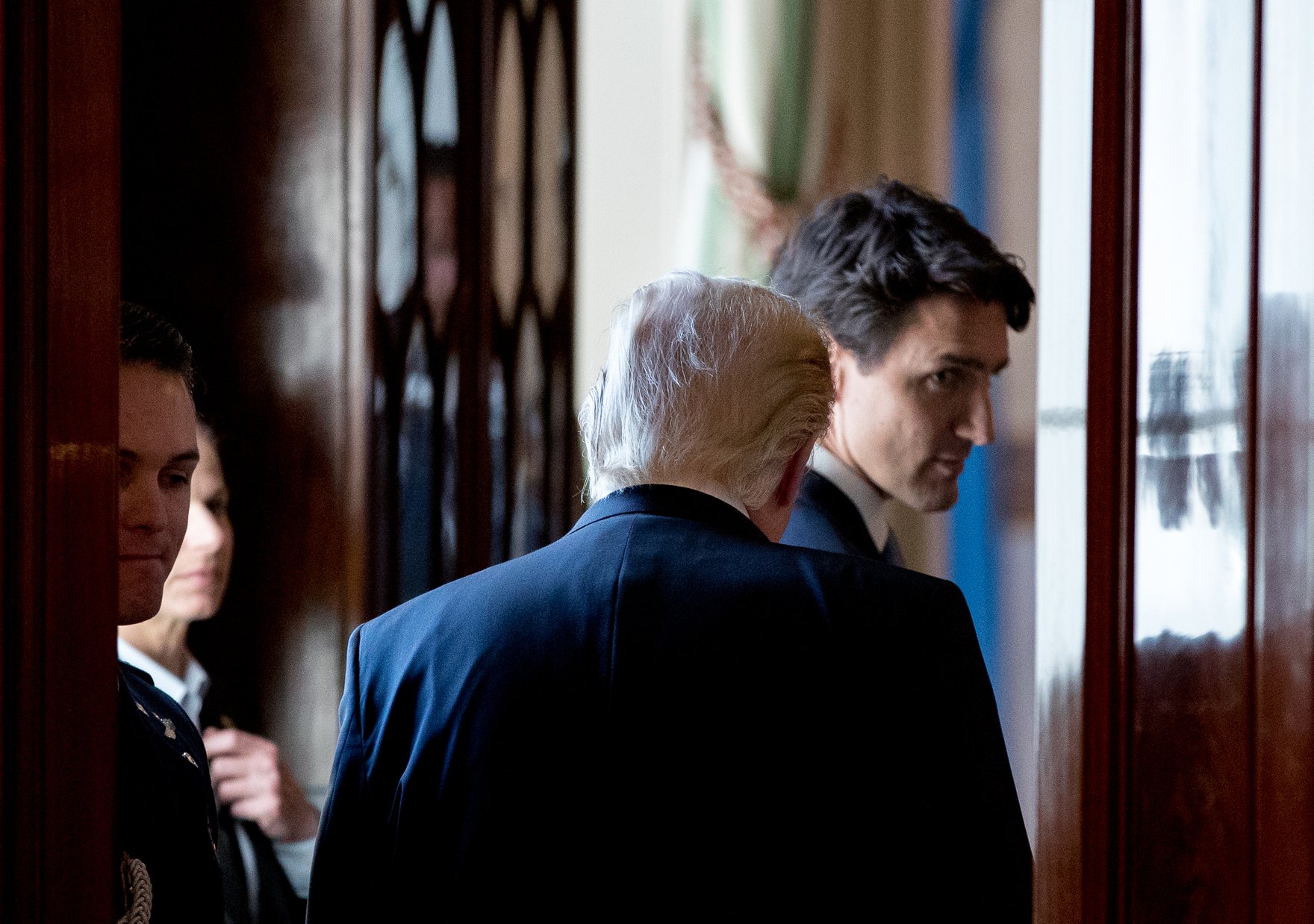Benjamin Franklin once said, “No nation was ever ruined by trade.”
Donald Trump seems determined to prove the US founding father wrong.
In 1960, trade was nine percent of US GDP; today trade comprises some 28 percent of US GDP. At the same time that trade is increasingly important to the American economy, the US president’s actions and policies will make it harder for other nations to find common ground with Washington on trade agreements.
During the presidential campaign, Trump promised to disrupt America’s long-standing efforts to negotiate bilateral, regional and multilateral rules to govern trade. With his usual flair for hyperbole, he called the North American Free Trade Agreement (NAFTA) “the worst trade deal maybe ever signed anywhere.” He stated that if he were president, the United States would drop out of “job-killing” agreements such as the Trans-Pacific Partnership. He promised to abandon some agreements and renegotiate regional and multilateral trade agreements on a bilateral level. Trump wanted the world to understand he would “put America first.” In so doing, he made it clear, he would give short shrift to the concerns of US trading partners.
As president, Trump has centralized trade policy making in the White House, while vacillating between protectionist rhetoric and mildly protectionist actions. For example, he threatened to label China and Germany currency manipulators, although the Treasury Department decreed neither nation met the criteria for such naming and shaming. Trump also used his bully pulpit to trash America’s closest trade partners, Canada and Mexico. Canada buys 18 percent of all American exports, more than any other country, yet Trump blasted Canada for dumping softwood lumber (a long-standing trade dispute). Trump also criticized Mexico for taking jobs from Americans — although one of the key objectives of NAFTA was to create enough economic growth in Mexico so that fewer Mexicans would illegally cross the border to find jobs in the United States.
Spring brought even more bellicose signals. In late April, Trump suggested that the White House is willing to disrupt long-standing trade relationships and risk trust in the United States. In an alarming move, Trump threatened to sign an executive order directing the United States to withdraw from NAFTA. He backpedalled after receiving advice from his cabinet, criticism from many members of Congress, and calls from the Canadian and Mexican leaders that they were willing to renegotiate the agreement — although US Commerce secretary Wilbur Ross added to the uncertainty this week, saying on Tuesday that “we have not yet decided whether to go the trilateral route or whether to pursue two matching bilateral deals.”
The president also directed the Commerce Department and the Office of the US Trade Representative to review all of America’s recent trade agreements. The executive order states that the president believes that trade agreements “must increase economic growth, contribute to the balance of trade, and strengthen the manufacturing base.” The order explains that these agreements are unfair if they harm “American workers, manufacturers, ranchers, business, intellectual property rights, innovation, or research.” And in a sign of the administration’s lack of understanding of trade and of fairness, the order stated that the United States would rely upon annual trade deficits as the one metric to determine if America is being treated “fairly” by its trade partners. Some observers were left to wonder how this metric, which generally moves in lockstep with net national borrowing, could illuminate whether a trade agreement’s provisions are fair. Taken in sum, Trump’s rhetoric and actions alienated allies and trade partners whose help and understanding America has relied on and whose support might be needed in other areas of foreign policy.
Trump and his advisers appear not to understand key aspects of trade policy.
First, many Americans are deeply tied to the global economy as consumers, producers, taxpayers, citizens or shareholders saving for college or retirement. Recent polling data reveals that they are supportive of trade and trade agreements as tools to shape globalization and do not necessarily embrace protectionism. Gallup surveyed 1,035 Americans in February 2017, and found a record-high 72 percent see foreign trade as an opportunity for economic growth, up from 58 percent in 2016. Some 71 percent of those polled say promoting favourable trade policies is “very important” (although “favourable” was not defined). While many Americans blame trade for job loss, and the decline of manufacturing employment in particular, in April 2017 the Pew Research Center reported that some 52 percent of Americans say free trade agreements are good for the United States, while 40 percent view them as bad. Pew also found younger and more educated people tend to be more supportive of trade agreements. Clearly, Americans see opportunity in the global economy, although they have concerns about the potential effects of trade agreements.
Second, Trump has indicated that any new trade deals will be bilateral rather than among several or many nations at a time. Trump and his team presume the United States will have more leverage in one-on-one talks. But his vision of US leverage in the global economy is a bit outdated. The US economy is growing, but its share and influence are shrinking relatively as the share of other countries in global GDP and trade grows. At the dawn of the twenty-first century, the United States contributed some 30 percent of global GDP; in 2015, the US share of world GDP was 24.32 percent. In 2016, the EU 28 comprised the world’s largest exporter of goods, followed by China and the United States. While the United States is the largest exporter of services, and services are increasingly important to trade, China is now the world’s largest manufacturer and trading nation. Thus, the United States has less leverage in many aspects of trade talks. Moreover, for many sectors, countries have alternative suppliers, which could make the United States relatively less attractive. Meanwhile, there is no evidence that negotiators can achieve better results with bilateral negotiations. Bilateral negotiations are more time- and labour-intensive. And bilateral trade talks simply would not be useful in negotiating rules for new sectors such as digital trade. The platform for facilitating information flows — the Internet — is designed to be universal and global. Hence, the system of rules governing trade in information flows needs to be global as well.
Third, many Trump administration officials talk about trade as if it is some form of sport with two teams that can have only one winner. Trump insists that after he renegotiates these agreements, America and Americans will again be winners. But the United States and many of its trade partners are diversified modern economies with many different sectors — from agriculture to 3D printing to health care. Each sector could be affected differently through trade negotiations; hence, there can be no overall victory for US citizens and companies. Depending on a sector’s competitiveness and other factors such as governance, some sectors and individuals may benefit more than others from trade liberalization, and some sectors and individuals may not benefit at all. Moreover, the effects of trade agreements are likely to vary over time, as markets, technologies and governance evolve over time. In any trade negotiation, the United States has many issues that it wants to promote — from regulating in a fair transparent manner, to advancing labour rights. Here, too, shrewd negotiators will have to pick and choose their priorities. No country can get everything it wants. In recognition that trade negotiations are complex, trade negotiators strive to achieve reciprocity; Country A trades off market access or a system of rules in one sector for another sector and Country B does the same. Reciprocity makes it easier for negotiators to find compromises on an issue or in a sector.
Fourth, while the president sets the tone, he does not set the objectives and strategy for the United States on trade. Under the US Constitution, he cannot make trade policy on his own. Trade policy-making authority is shared between the executive and legislative branches. Many members of Congress are deeply concerned with the direction of trade policy and disagree with how Trump is treating America’s trade partners. Democrats and Republicans are publicly criticizing his approach and perspective.
Finally, Trump does not seem to understand what trade agreements do and why they are helpful to individuals and firms engaged in trade as consumers, producers, taxpayers and investors. They are designed to build trust among people and firms who may not know each other but want to engage in trade. In fact, humans have drafted trade agreements since ancient times. The ancients didn’t know who made the goods they desired or how these goods were produced. They learned to rely on trade agreements, which allowed them to make commitments, take a leap of faith and exchange goods for money.
Trump is not alone in his misunderstanding of what trade agreements do. These agreements are long and complicated, and cover a wide range of issues that at first blush don’t look like trade issues. Really, they are governance agreements that set rules to govern trade. Policy makers use these agreements to limit how and when nations can erect barriers to trade and when nations might take exception to these rules. Over the years, policy makers have negotiated and renegotiated trade agreements to ensure that they reflect how markets, technologies and governments have evolved. In the nineteenth century, trade agreements covered only border measures such as tariffs and quotas. But in the twentieth century, policy makers began to focus on domestic policies such as regulations, standards and subsidies, which also could distort trade. As they included such non-tariff barriers, trade negotiators expanded the definition of unfair trade beyond the misuse of border measures and got deeper into domestic regulatory policies. Not surprisingly, some critics see these agreements as breaching sovereignty, undermining democracy and being unfair, because they essentially “re-regulate.”
However, Trump administration officials don’t acknowledge the many types of “fairness” governed by recent trade agreements. Since 1974, the Congress has required that trade agreements signed by the United States include language on non-tariff trade barriers such as health and safety regulations, product standards and, more recently, even language on online privacy and regulatory transparency. Signatories must ensure that when they regulate they do so in the least trade-distorting manner. The United States also requires that its trade partners allow their citizens and foreign producers not only to comment on potential regulations that can have trade effects but also to challenge regulations that distort trade. Because trade agreements require trade partners to regulate transparently and in the least trade-distorting manner possible, these agreements could make trade “fairer” for more people more of the time.
In sum, trade agreements are all about creating and maintaining trust among citizens, policy makers and firms in different nations. However, with his recent executive order on trade and his threats to pull out of NAFTA, Trump is telling citizens, executives and policy makers from other countries that he not only distrusts these agreements, he distrusts them because he presumes they are acting in ways that are unfair to Americans. Moreover, should his administration determine that an agreement needs renegotiation, Trump will struggle to regain the trust of other countries he has labelled “unfair.” As the United States dithers, the European Union, China, Canada and Mexico will continue to negotiate trade agreements, pivoting away from the United States as the fulcrum for trade policy. These nations will set the rules for key sectors such as digital trade. Trump’s rhetoric and policies will likely to make it harder for Americans to lead and effectively participate in twenty-first-century markets. That could be ruinous for America.



